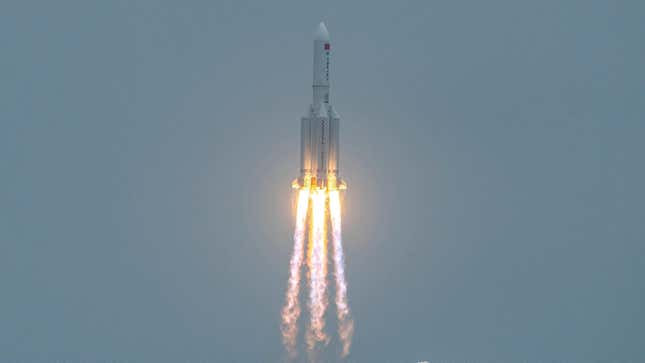
An out-of-control Chinese rocket is scheduled to reenter Earth’s atmosphere this weekend, but no one is sure exactly when or where the debris will land. Here’s why we don’t yet know and, more importantly, when we can expect to find out.
During the Apollo era, the atmospheric reentry time of the arriving command modules could be predicted down to the exact second. As to when the core stage of China’s Long March 5b rocket—currently tumbling in low Earth orbit—will perform its reentry remains an open question. Without knowing the reentry time, predicting a possible impact zone is impossible.
As of this posting, the Aerospace Corporation estimates that the CZ-5B rocket body will finally fall toward Earth at 11:53 p.m. EDT on Saturday May 8 (03:53 UTC on Sunday May 9), with a plus-minus of 11 hours, while SpaceTrack.org has it happening about 30 minutes earlier, with a plus-minus of nine hours.
The heavy-lift rocket launched on April 29, but its 98-foot-tall core stage, instead of falling back to a predetermined location on Earth, entered into orbit, setting the stage for an uncontrolled atmospheric reentry.
As to where the debris will end up, that’s even more uncertain. The potential geographic area is massive, including most of North and South America, Africa, Australia, the Middle East, and all of southern Eurasia, in addition to the Atlantic and Pacific oceans. A slightly out-of-date Aerospace Corporation tweet, shown below, shows the possible geographical range (the horizontal area containing all the squiggly lines) for the falling debris.
So why were we able to predict the arrival of Apollo capsules to such precision, but not this core stage?
“The thing about the Apollo spacecraft is that they came in vertically from the Moon, so we knew the exact orbit,” Jonathan McDowell, an astrophysicist at the Harvard-Smithsonian Center for Astrophysics, explained to me over the phone. “But this rocket is moving tangent to the atmosphere—it’s body surfing the outer atmosphere horizontally, and constantly grazing it as the rocket comes down towards it.”
As a result, it’s difficult to predict when the rocket will heat up to the point that the structure will start to melt and fall to Earth, he said. This will depend on the various materials that comprise the rocket, its particular way of tumbling, and the changing density of the upper atmosphere, which varies each day due to space weather and solar activity, according to McDowell.
Experts on the ground are doing their best to track the object, keeping note of its altitude, speed, and other factors, while continually updating the models. The closer we get to the actual reentry date, the more accurate the predictions will become. It’s like “trying to predict the weather a week out as opposed to tomorrow,” said McDowell, as there’s “less extrapolation involved.” He expects the margin of error to continually shrink over the next few hours, saying that by Saturday morning it should be down to a window of around six hours. Eventually, we’ll get to the point where we will know exactly when it will fall out of the sky. Unfortunately, predicting a potential landing site is nigh impossible before that, because “a one-hour error in the reentry time is an 18,000-mile error in the location,” as McDowell explained previously.
McDowell predicts two possible outcomes for when we’ll all find out where this thing landed.
“One possibility is that it’ll land in the middle of the Pacific Ocean, because that’s most of Earth,” he said. The U.S. Space Force will know immediately when it reenters the atmosphere thanks to infrared telescopes, which will see the flare as the rocket breaks up. The Space Force will know the “exact time to the minute” and the “exact location” of the point where it entered the atmosphere, McDowell said, but the military won’t tell the rest of us right away because that data is “sort of secret.”
The Space Force will “launder it through various levels of bureaucracy until it appears on a space tracker website, and we’ll have to pretend we don’t know this data came from early warning satellites,” said McDowell. In his experience, the required sign-offs, approval, and permission to make this information available on the web takes about three hours.
A similar set of events could unfold should the rocket break up over an uninhabited landmass, with the site of impact being revealed about three hours after the fact. But he foresees a very different finale should pieces of the disintegrating core stage crash onto a populated area.
“Then we’ll know within about 10 minutes, as people’s Twitter will furiously light up,” he said.
More: Astronomers capture wild image of China’s out-of-control rocket.